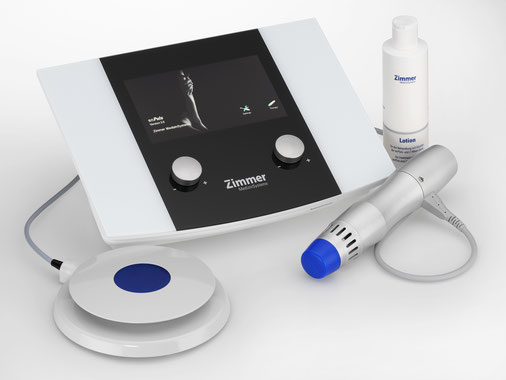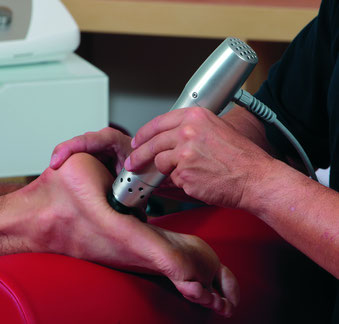

Radial Extracorporeal Shockwave Therapy
An effective non-surgical solution!
What is it?
Radial Extracorporeal Shockwave Therapy (rESWT) is a non-invasive treatment in which a device is used to pass acoustic shockwaves at a set frequency through the skin to the affected area. It is purely a mechanical wave – not an electric one. Shockwave is an accepted intervention in the UK and treatment may provide pain relief for chronic tendinopathies.
How does it work?
The treatment initiates a pro inflammatory response in the affected tissue that is being treated. The body responds by increasing the blood circulation and metabolism in the affected area which accelerates the body’s own healing processes. The shockwaves can break down injured tissues and calcifications. As a result of cellular tissue micro-trauma, it can provide a temporary analgesic effect on afferent nerves providing immediate pain relief, known as ‘hyper-stimulation anesthesia’.
How is the shockwave delivered?
The painful area is located by palpation. The treatment is delivered via an electromagnetically accelerated, ballistic projectile which transfers its kinetic energy to a transmitting head in a hand piece. The shockwave radiates out through the head into the affected area. Contact gel is sometime used on the skin to improve the transmission of the shockwave.
Why chose rESWT?
Shockwave therapy stimulates and supports the body’s self-healing mechanisms. rESWT is a non-invasive treatment modality – there are no medications such as cortisone or surgery involved. There are no major safety concerns associated with rESWT. It is common to have some immediate pain relief and studies have shown positive outcomes in approx. 70% of cases. It is included in the NICE guidelines for the management of refractory (chronic) tendinopathies.
HEre are some examples of Conditions which Radial Shockwave Therapy is an effective treatment FOR:
- Jumper’s Knee (patella tendinitis)
- Painful Shoulder
- Tennis Elbow (lateral epicondylitis)
- Golfers Elbow (medial epicondylitis)
- Heel Spur
- Plantar Fasciitis
- Insertional Pain
- Chronic Tendinopathy
- Shin Splints (medial tibial stress syndrome)
- Myofascial Trigger Points
- Calcific tendonitis of the shoulder
- Trochanteric bursitis
- Achillodynia
Frequently Asked Questions:
How long does the treatment session last?
The rESWT application lasts 3-5 minutes to deliver 1500 – 2500 shockwaves. A course of 3 – 6 treatments is required and these can be spread out with 7 – 10 days in between. The treatments will be followed by a course of rehabilitation designed to strengthen the affected area.
Is the shockwave treatment painful?
The treatment itself can be painful during the application of the rESWT. The treatment is delivered according to patient response, if a patient is unable to tolerate the pain levels the settings will adjusted to reduce the discomfort. A mild ache may occur later that day but should pass after a day. A patient may therefore take analgesic pain relief afterwards if required or before attending their next session.
What are the criteria for referral for rESWT?
Patients must have an on-going tendinopathy for more than 3 months and have failed at least one course of conservative treatment such as physiotherapy, injection therapy or orthotics.
Is Shockwave therapy appropriate for everybody?
While Shockwave therapy is suitable for a large number of conditions with minimal side effects there are some conditions, also known as contraindications, that make Shockwave unsuitable for a patient:
- If you are pregnant
- If you have a blood clotting disorder (including thrombosis)
- If you are taking oral anti-coagulants
- If you have received a steroid injection within 6 weeks
- If you have a pacemaker fitted
- If tumors are present at the treatment site
- If you have an infection or abrasion at the treatment site
- If you are under 18 (except in the treatment of Osgood-Schlatters disease)
- Any treatment over an air filled cavity such as lungs or guts
However, many patients with the conditions above can benefit from soft tissue therapy
